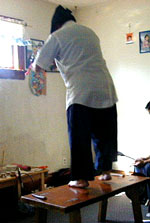By Kaomi Goetz
Minnesota Public Radio
August 27, 2001
Although many Hmong in the state are fast becoming "Americanized" like generations of immigrants before them, many still practice religious beliefs dating back to 3000 B.C., when Chinese scholars first recorded the civilization.
| |
|
|
|
||
For traditionalists, almost all aspects of Hmong life are thought to be connected with supernatural beings. An understanding of this co-existence between a spirit world and a physical one is paramount to understanding Hmong rituals and sacrifices. The spirit world is believed to harbor a variety of spirits that can affect someone's daily life, such as ancestral spirits, house spirits, nature spirits, as well as evil ones.
It is believed that all Hmong are allotted a finite number of days on Earth and are determined at birth according to which clan you are born unto. Many ritual ceremonies are performed to fulfill the will of one's ancestors and of the spirits. The Hmong believe these spirits live in each corner of a house - in the doorways, in the framework, around an altar. They are also present in nature, and thought to be represented by mountains, trees, streams, ponds, and valleys. The religion is based on a person's relationship with and bondage to the spirits.
"You give it praise when things are good," Ilean Her, Executive Director of the Council of Asian Pacific Minnesotans says of the spirits, "and offer payment when things are bad."
Part of this payment could be an animal sacrifice, whose value is contingent on its size. For example, a goat is considered the strongest or greatest payment that could be made to the spirits. In descending order, a cow, a pig or chickens are thought to have lesser sacrificial value. To treat common colds, fever, or more simple illnesses, mere chickens would suffice as proper offering. But for those of a more serious nature, like epilepsy and mental illness, the highest type of sacrifice is required.
A shaman is the intermediary between the two dimensions, and oversees all rituals that require contact with the spirits. A shaman can do battle with evil spirits and negotiate with spirits to restore order in the physical world. When traversing back into a spirit world, a shaman will cover his eyes with a cloth hood, to be able to "see" the spirits. A shaman will chant and dialogue with the spirit world. A precursor to becoming a shaman is usually some type of near-death experience.
Healings can occur immediately, but often take a few days and even months. The best portion of the sacrificial meat goes to the shaman, and in scarcer times, this would suffice. Today, shamans will often also receive a cash payment in increments of $50, $100, $200 or $300. The exact amount depends on several variables, such as the reputation of the shaman and the degree of healing required.
If a ritual is not successful, Ilean Her says the shaman is not to blame. "The Hmong just think it's because the evil spirits are back or that they are more powerful," says Her. "[In that case] another, stronger, and more elaborate ceremony will have to take place," she says. Some might even contact other shamans in the hopes of improving their ritual's outcome.
According to the latest U.S. Census, about 42,000 Hmong currently live in Minnesota, though Hmong leaders say this number is undercounted. Va-Leng Cha of the Hmong National Organization says as many as half of the Hmong may have now converted to Christianity, though many of them still observe shaman rituals.
While there is no standard set of rules for Hmong rituals and practices, they typically are passed on to each new generation, carried on by oral and demonstrated tradition. Clan and lineage variations also come into play.
The Hmong believe in reincarnation of the soul into other life forms. People can come back as other humans, animals, rocks, trees, and flowers. They believe that the souls of the deceased will come back into new members of Hmong families. Safe passage, fruitful lives and good health are just a few of the things that can be secured by having a good shaman.

